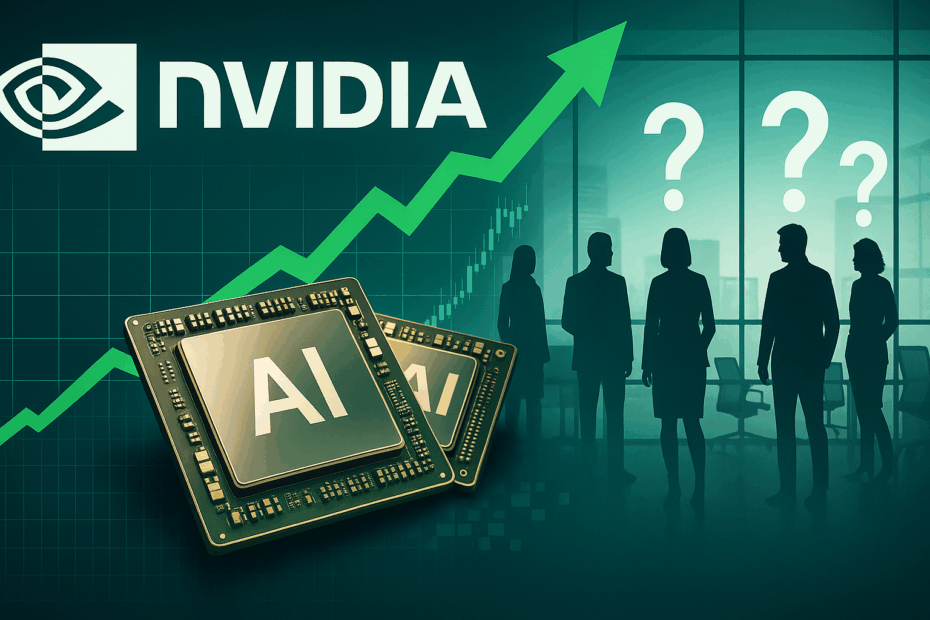TL;DR — NVIDIA just posted another blow-out quarter, pulling in a record $44.1 billion in revenue (-a 69 % jump YoY), but it also took a $4.5 billion hit from new U.S. export rules on its “H20” China-only chips and warned of an $8 billion revenue hole next quarter. At almost the same moment, Anthropic CEO Dario Amodei sounded the alarm that AI could wipe out up to half of all entry-level white-collar jobs within five years—an outlook some, including Mark Cuban, flatly reject.
1. NVIDIA’s Q1 FY 2026 by the numbers
| Metric | Q1 FY 26 | YoY | Notes |
|---|---|---|---|
| Revenue | $44.1 B | +69 % | All-time high, beats Street |
| Data-center revenue | $39.1 B | +73 % | 89 % of total sales |
| Adjusted EPS (ex-China charge) | $0.96 | +57 % | Tops est. $0.88 |
| One-time China charge | $4.5 B | — | Linked to H20 export curbs |
| Q2 guidance | $45 B ± 2 % | — | Includes -$8 B China hit |
“Global demand for AI infrastructure is incredibly strong…countries now see AI as critical as electricity.” — CEO Jensen Huang(NVIDIA Newsroom)
Context & color
- Export-rules whiplash. U.S. licensing rules barred shipment of H20 chips to China, causing both the charge and the predicted $8 B shortfall — yet customers front-loaded orders ahead of the ban, cushioning Q1.(Reuters, New York Post)
- Street reaction. Shares popped 4-6 % after hours as investors looked past the China drag to a still-blistering AI build-out in the Middle East, Europe, and the U.S.(Barron’s, Business Insider)
- Margin optics. GAAP gross margin fell to 60.5 % thanks to the charge, but would have been 71 % otherwise.(NVIDIA Newsroom)
2. Dario Amodei’s stark jobs warning
| Claim | Source | Key quote |
|---|---|---|
| 50 % of entry-level office jobs at risk within 5 years | Axios interview | “AI could spike unemployment to 10-20 % almost overnight.” |
| Government & industry “sugar-coating” risk | Business Insider | “Most people don’t believe this is coming.” |
Amodei worries that agentic AI will move from augmentation to full-on automation much faster than past tech shifts, leaving junior roles in finance, law, consulting, and tech particularly exposed.(Axios)
Push-back
- Mark Cuban’s rebuttal. The entrepreneur insists new AI-native firms will add more jobs than they delete, arguing that historic tech waves always grew net employment.(Business Insider)
- Investors’ lens. Even bearish takes concede that companies embracing AI early could see margin windfalls—fueling precisely the demand that lifted NVIDIA’s quarter.(Axios, Axios)
3. Why these two stories matter together
a. AI demand remains insatiable
NVIDIA’s numbers confirm that every hyperscaler and sovereign cloud is scrambling to lock up GPU supply now, ahead of regulation, geopolitics, or competitive catch-up.(The Guardian, New York Post)
b. The workforce transition is real—and uneven
If Amodei is half-right, junior white-collar attrition could hit just as AI infrastructure spend peaks. Enterprises will need simultaneous strategies for capacity building (chips, models) and human reskilling.(Axios)
c. Strategic take-aways for Veritopa clients
- Secure compute first. With supply still constrained, negotiate multi-year GPU commitments or cloud credits tied to NVIDIA’s Blackwell roadmap.
- Audit entry-level workflows. Identify tasks ripe for agentic AI—then design upskill paths before head-count cuts become default.
- Model the China factor. Even if you don’t serve China directly, export-rule volatility can ripple through supply chains and pricing; bake wider ranges into ROI.
- Experiment with “AI + human” teams. Early pilots show that pairing a senior operator with AI tools often beats both pure automation and larger junior teams on cost-to-output.
- Communicate transparently. Amodei’s core criticism is lack of candor. Companies that explain where AI is headed—and how employees can ride the wave—will recruit and retain better.
4. Bottom line for readers
NVIDIA’s blockbuster quarter proves that AI infrastructure spend is still accelerating, even under heavy export headwinds. At the same time, leading practitioners like Dario Amodei are telegraphing a near-term white-collar job shock. Smart firms should treat these as two sides of the same coin—investing aggressively in AI capability while mapping a humane, skills-first workforce transition.
